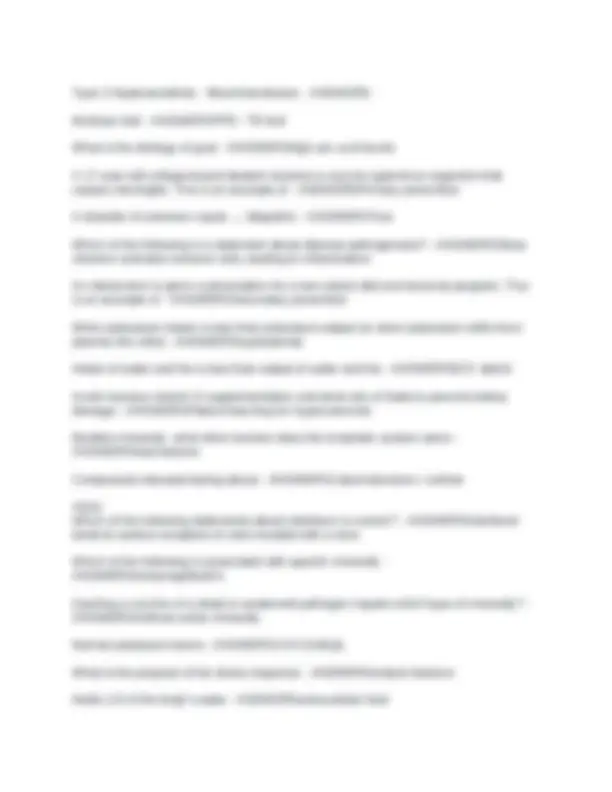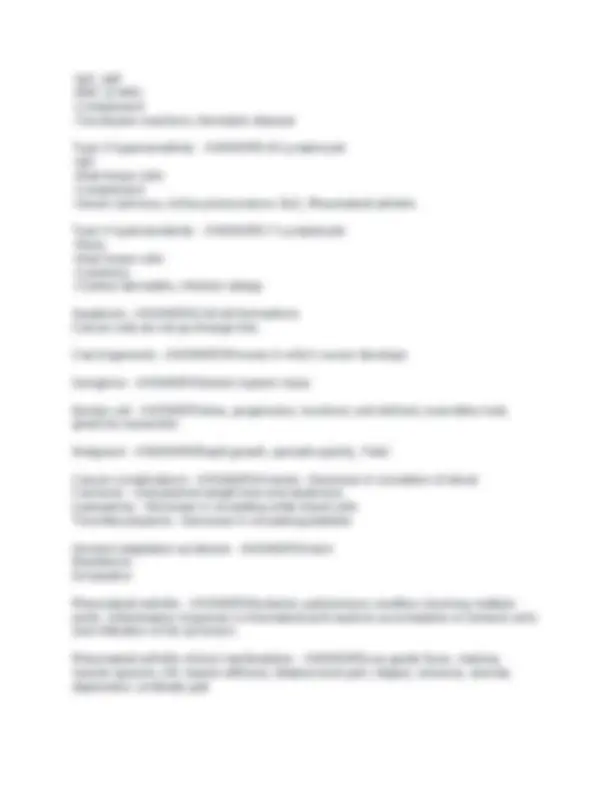








Study with the several resources on Docsity

Earn points by helping other students or get them with a premium plan


Prepare for your exams
Study with the several resources on Docsity

Earn points to download
Earn points by helping other students or get them with a premium plan
Community
Ask the community for help and clear up your study doubts
Discover the best universities in your country according to Docsity users
Free resources
Download our free guides on studying techniques, anxiety management strategies, and thesis advice from Docsity tutors
A comprehensive review of key concepts related to homeostasis, immunity, and inflammation, essential for understanding human physiology and disease processes. It includes multiple-choice questions and answers covering topics such as fluid balance, electrolytes, stress response, hypersensitivity reactions, and cancer pathogenesis. This resource is valuable for students in nursing or related healthcare fields.
Typology: Exams
1 / 11

This page cannot be seen from the preview
Don't miss anything!







Which of the following assessment findings indicates an alteration in homeostatic control mechanisms? - ANSWERSFever
135-145 mEq/L - ANSWERSsodium serum range Alarm stage of GAS - ANSWERSincreased heart rate Which space does fluid enter to cause edema - ANSWERSinterstitial compartment Treats hives, pruritis and swelling - ANSWERShistamine and prostaglandin Macrophage is a type of white blood cell which is a phagocyte. - ANSWERSTrue zQuiz Allergies are associated with elevated - ANSWERSeosinophils What causes edema? - ANSWERSIncrease in capillary hydrostatic pressure Oncogene is associated with the initiation of cancer - ANSWERSTrue Gout is caused by the following: - ANSWERSelevated uric acid Glucocorticoids reduce inflammation by - ANSWERSdecreasing the permeability in capillaries Wound edges that are approximated signify the wound is infected - ANSWERSFalse Which of these exemplifies habituation - ANSWERSloud noise no longer causes fight/flight response Ecchymosis means - ANSWERSlarge bruise Purpura means - ANSWERSmedium bruise Tumors "new growth" not all are life threatening; benign or malignant- Describes - ANSWERSneoplasm May be Primary Bone Cancer or Metastatic - ANSWERSClinical manifestation of Chondrosarcoma Shingles is a disorder of herpes zoster and has which of the following clinical manifestations? - ANSWERSPsoriasis Eruption of vesicles along sensory neuron dermatomes Distribution of fluid between interstitial and intracellular compartments occurs by - ANSWERSosmosis A patient describes nausea. What is this? - ANSWERSSymptom
A simple lab test which can measure the level of inflammation in an individual is - ANSWERSErythrocyte sedimentation rate (ESR) The process by where we use hormones in the body to regulate equilibrium, when the body changes - ANSWERSHomeostasis Negative feedback - ANSWERSuses hormone to reach homeostasis Positive feedback - ANSWERSincreases hormones to create a reaction to occur What the four different parts of homeostasis - ANSWERSEtiology, Pathogenesis, Clinical manifestations, Treatment implications What are the levels of prevent - ANSWERSPrimary - Preventative measure Secondary - Detection Tertiary - Reducing effects Mitochondria - ANSWERSPowerhouse of the cell Produces ATP (Glucose+O2) Osmosis - ANSWERSMovement of water across a semipermeable membrane What are the fluid compartments - ANSWERSICF and ECF Sign - ANSWERSObjective - Rash, erythema Symptom - ANSWERSSubjective - Fever, naseu How is fluid between interstitial and intracellular compartments distributed? - ANSWERSOsmosis Main complication of sodium imbalance - ANSWERSHyper/Hyponatremia Concern - Hypovolemia Kidney failure Main complication of calcium imbalance - ANSWERSHypercalcemia/Hypocalcemia Kidney disease How is fluid lost from the body - ANSWERSFeces, urine, insensible loss
-IgG, IgM -RBC & WBC -Complement -Transfusion reactions, Hemolytic disease Type 3 hypersensitivity - ANSWERS-B-Lymphocyte -IgG -Host tissue cells -Complement -Serum sickness, Arthus phenomenon SLE, Rheumatoid arthritis Type 4 hypersensitivity - ANSWERS-T-Lymphocyte -None -Host tissue cells -Cytokines -Contact dermatitis, Infection allergy Apoptosis - ANSWERSCell kill themselves Cancer cells do not go through this Carcinogenesis - ANSWERSProcess in which cancer develops Gangrene - ANSWERSSevere hypoxic injury Benign cell - ANSWERSslow, progressive, localized, well defined, resembles host, grows by expansion Malignant - ANSWERSRapid growth, spreads quickly, Fatal Cancer complications - ANSWERSAnemia - Decrease in circulation of blood Cachexia - Unexplained weight loss and weakness Leukopenia - Decrease in circulating white blood cells Thrombocytopenia - Decrease in circulating platelets General adaptation syndrome - ANSWERSAlarm Resistance Exhaustion Rheumatoid arthritis - ANSWERSSystemic autoimmune condition involving multiple joints. Inflammatory response in rheumatoid joint leads to accumulation of immune cells and infiltration of the synovium Rheumatoid arthritis clinical manifestation - ANSWERSLow grade fever, malaise, muscle spasms, AM muscle stiffness, bilateral joint pain, fatigue, anorexia, anemia, depression, unsteady gait
Oblique fracture - ANSWERSat an angle to the bone shaft Spiral fracture - ANSWERSTwists around the bone shaft Comminuted fracture - ANSWERSMultiple fracture lines and bones pieces Greenstick fracture - ANSWERSIncomplete break in the bone, only slight bend Compression fracture - ANSWERSBone is crushed or collapses / small pieces Complete fracture - - ANSWERSbroken into two or more sperate pieces Incomplete fracture - ANSWERSPartially broken Open fracture / Compound - ANSWERSSkin is broken and bone protrude Closed fracture - ANSWERSSkin is intact Impacted fracture - ANSWERSone end of the bone is forced into the adjacent bone Pathologic fracture - ANSWERSfracture caused by diseased or weakened bone Stress fracture - ANSWERSrepeated excesssuve stress Depressed fracture - ANSWERScranium is fractured inward toward the brain Shingles - ANSWERSviral disease that affects the peripheral nerves and causes blisters on the skin that follow the course of the affected nerves Scabies - ANSWERScontagious skin disease transmitted by the itch mite, commonly through sexual contact Complications of fractures - ANSWERS• Acute compartment syndrome
IgG - ANSWERSMain defense against bacteria - (passive immunity) IgM - ANSWERSFight blood infections and triggers production of IgG IgA - ANSWERSFound in membranes of respiratory and gastrointestinal tract - Local immunity IgE - ANSWERSProtects the body through its presence in mucous membranes - Allergic reactions IgD - ANSWERSPresent in blood serum and B cells; receptor for antigens Complement - ANSWERSInactive proteins in the circulation that when activated stimulate the release of mediators, chemotaxis, and phagocytes Prostaglandins - ANSWERSlipid compounds that control Constriction or dilation of vascular smooth muscle, cell growth, sensitization of spinal neurons Etiology - ANSWERScause of the event Pathogenesis - ANSWERSEvolution of the disease Clinical manfiestations - ANSWERSstates of the disease / S/s Glucose lab value - ANSWERS70-99 mg/dl Sodium lab value - ANSWERS136-144 mEq/L Potassium lab value - ANSWERS3.7-5.2 mEq/L Chloride lab value - ANSWERS96-106 mmol/L Calcium lab value - ANSWERS8.5-10.9 mg/dl